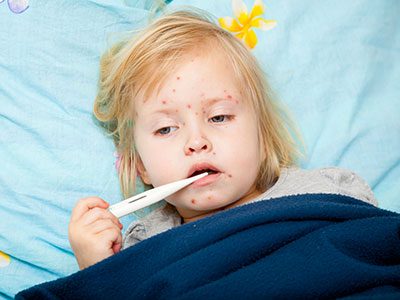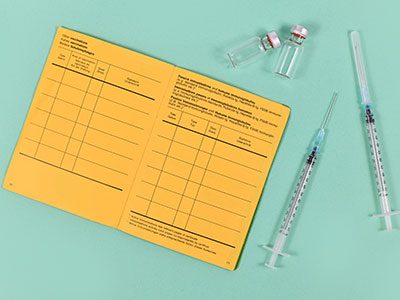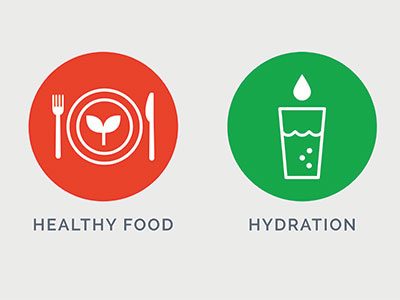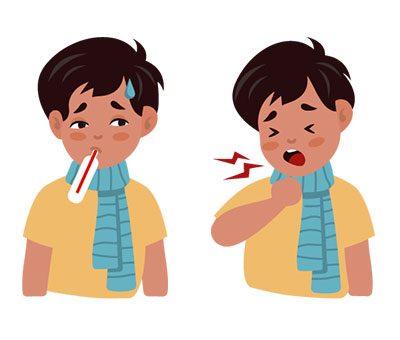While measles was declared eliminated in the United States in 2000, it is still common around the world. Measles can come into our country easily through visitors or returning Americans who have traveled abroad and brought it back. As a result, measles outbreaks still occur every year in the United States. Here are five facts to know about measles.
1. What is measles?
Measles, also called rubeola, is a viral respiratory disease and one of the most highly contagious diseases known. It is spread from one child to another through direct contact with discharge from the nose and throat, or via air-borne droplets from an infected child. Measles results in a distinct rash and is usually accompanied by fever and cough.
The measles virus, which causes the disease, is classified as a Morbillivirus. It is mostly seen in the winter and spring, but measles is preventable with proper immunization.
The measles vaccine is usually given in combination with the mumps and rubella vaccine. It is called the MMR and is usually given when the child is 12 to 15 months old and then again between 4 and 6 years of age.
2. How is measles spread?
Measles is one of the most contagious diseases known to medicine, capable of spreading with remarkable efficiency. Understanding how the virus transmits can help parents better protect their children and community.
Measles primarily spreads through the air when an infected person coughs or sneezes. The virus can remain suspended in the air for up to two hours after the infected person has left the area. This means you don’t need direct contact with someone who has measles to catch it — simply breathing the same air in a room where an infected person was present can be enough.
The virus can also spread through direct contact with infectious droplets on surfaces, though this is less common than airborne transmission. When someone touches a contaminated surface and then touches their eyes, nose, or mouth, they can transfer the virus.
3. What are the symptoms of measles?
After exposure to the disease, it can take between 8 to 12 days for a child to develop symptoms of rubeola. Children are contagious 1 to 2 days before the onset of symptoms and 3 to 5 days after the rash develops. This means that children can be contagious before they even know they have measles.
During the early stages of measles (which lasts between 1 to 4 days), symptoms usually resemble those of an upper respiratory infection. Each child may experience symptoms differently, however. Common symptoms may include:
- Hacking cough
- Redness and irritation of the eyes
- Fever
- Small red spots with white centers on the inside of the cheek (these usually occur two days before the rash on the skin appears)
- A deep, red, flat rash that starts on the face and spreads down to the trunk, arms, and legs. The rash starts as small distinct lesions, which then combines to form one big rash. After 3 to 4 days, the rash will begin to clear, leaving a brownish discoloration and skin peeling
The most serious complications from measles include the following:
- Ear infections
- Pneumonia
- Croup
- Inflammation of the brain
The symptoms of rubeola may resemble other skin conditions or medical problems. Always consult a physician for a diagnosis.
4. How can parents protect children from the measles?
Measles is a viral infection that’s highly contagious and serious for small children, but it is also 97 percent preventable by a vaccine.
The Centers for Disease Control (CDC) recommends the MMR vaccine, which also includes protection against mumps and rubella, for all children at age 12–15 months, with a second dose before the start of kindergarten or at age 4–6 years old. Two doses are also recommended for healthcare providers and post-high school-aged young people or students headed off to college. Infants ages 6 through 11 months of age who are travelling internationally should receive one dose of MMR vaccine.
If you’re unsure if you or other family members are protected against measles, try to find your vaccination records or written documentation of measles immunity. If you cannot find records, receiving an extra dose of the MMR vaccine is not harmful and can be discussed with your child’s doctor.
5. Vitamin A and cod liver oil do not prevent or cure measles
Despite persistent myths, vitamin A and cod liver oil cannot prevent or cure measles. While vitamin A supplements are recommended by health organizations to reduce measles complications in vitamin A-deficient children, they don’t prevent infection or cure the disease. Well-nourished children in developed countries such as the United States generally don’t benefit from additional vitamin A during measles, and cod liver oil has no proven effect against the virus.
When to call the pediatrician
Call your pediatrician immediately if you suspect your child was exposed to measles or exhibits symptoms. It’s particularly important if your child is an infant, is taking immune suppressant medication or has a medical condition that affects the immune system such as cancer or tuberculosis.
If a child is exposed and has not been immunized, vaccination within 72 hours of exposure may help prevent the disease.
 https://riseandshine.childrensnational.org/wp-content/uploads/2020/11/person-being-vaccinated-feature.png
300
400
Rise and Shine
https://riseandshine.childrensnational.org/wp-content/uploads/2017/11/childrens_riseandshine_logo.jpg
Rise and Shine2025-05-15 07:00:242025-05-23 10:39:33Answers to your questions about the COVID-19 vaccine and booster for children
https://riseandshine.childrensnational.org/wp-content/uploads/2020/11/person-being-vaccinated-feature.png
300
400
Rise and Shine
https://riseandshine.childrensnational.org/wp-content/uploads/2017/11/childrens_riseandshine_logo.jpg
Rise and Shine2025-05-15 07:00:242025-05-23 10:39:33Answers to your questions about the COVID-19 vaccine and booster for children




















Leave a Comment
Want to join the discussion?Feel free to contribute!